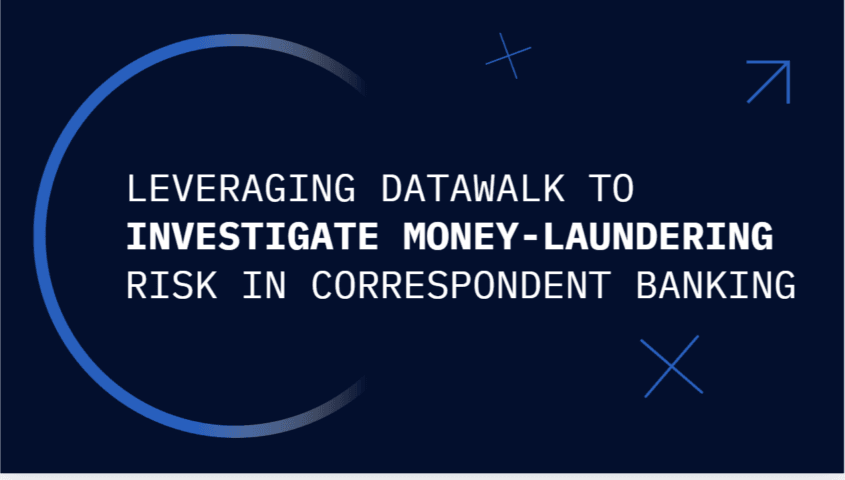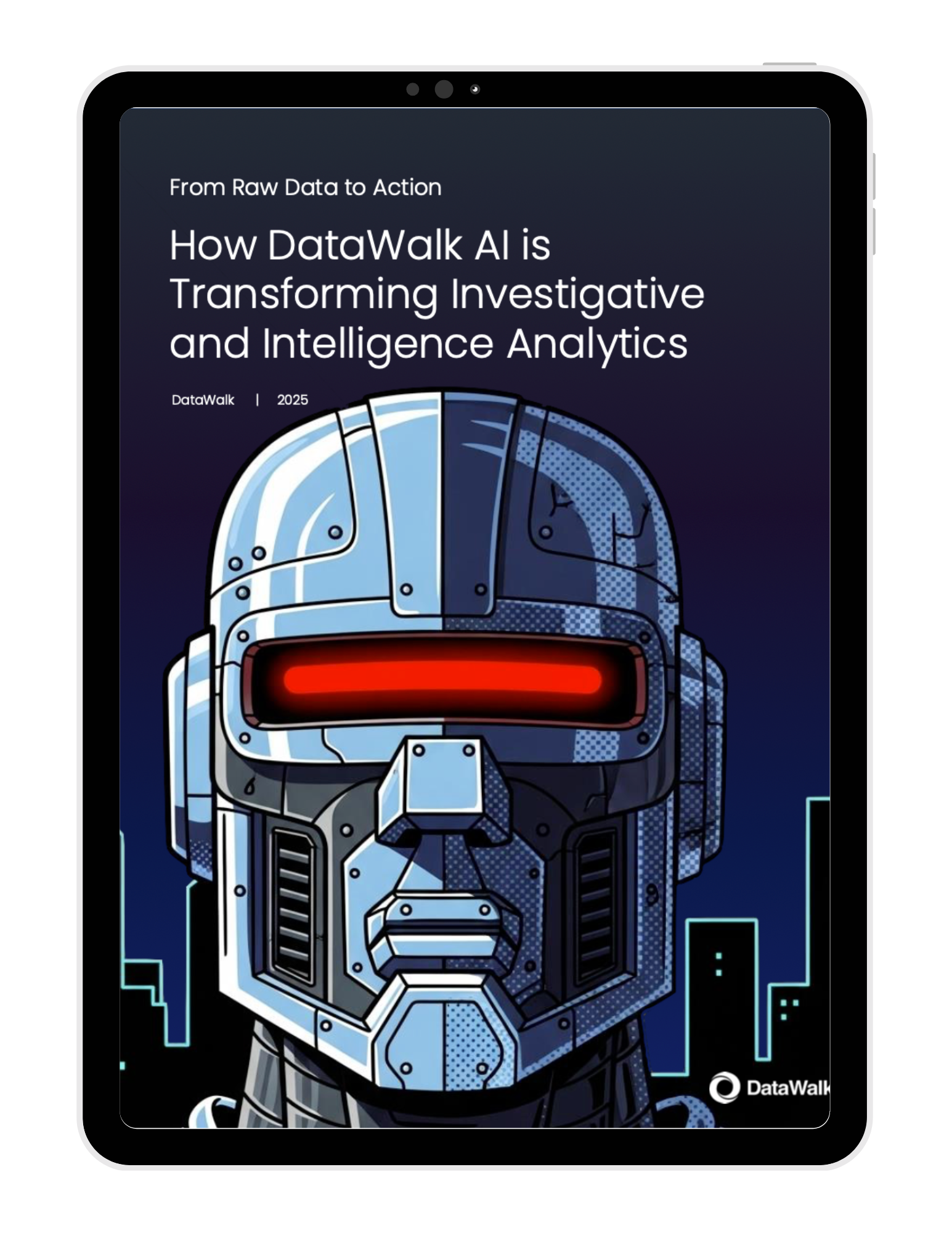
Leveraging DataWalk to Investigate Money-Laundering Risk in Correspondent Banking
Correspondent banking relationships allow banks to serve customers in foreign markets without maintaining a local branch. While this cross-border infrastructure is essential for global commerce, it also creates fertile ground for money-laundering (ML) and terrorist financing (TF). Criminals exploit the reliance of one bank (the correspondent) on another bank’s (respondent’s) due-diligence practices. The inherent opacity of multi-party payment chains, nested accounts, and high-risk jurisdictions makes it possible for criminals to obscure the origin and destination of illicit funds. Consequently, regulators expect financial-crime units to monitor complex correspondent flows, detect emerging patterns, and document every decision with full transparency.
This article explores how DataWalk’s advanced graph analytics & AI platform helps banks mitigate the unique risks of correspondent banking while dramatically improving investigative efficiency. It focuses on the needs of AML investigation leaders who must protect their institutions from regulatory penalties and reputational damage while enabling investigation teams to work faster and smarter.
ACCELERATE YOUR INVESTIGATIONS WITH PROVEN STRATEGIES AND LESSONS FROM REAL-WORLD SUCCESS STORIES.
Gain access to the DataWalk articles and case studies
For FinCrime Investigators
Gain access to the DataWalk articles and case studies for FinCrime Investigators
Gain access to the DataWalk articles and case studies for FinCrime Tech Professionals
Challenges of Correspondent-Banking AML
Correspondent banking exposes institutions to a range of vulnerabilities that criminals actively exploit:
- Channel risk: The correspondent bank often trusts the respondent’s AML controls.
- If those controls are weak, illicit funds can move across borders unchecked.
- Jurisdictional risk: Criminals route payments through high-risk or poorly regulated countries to avoid scrutiny.
- Layering and transaction chaining: Automated transfers create a complex web of cross-border transactions, obscuring origins.
- Circular transactions and nested accounts: Multiple correspondent accounts allow criminals to loop funds through different banks, hiding beneficial ownership.
- Trade-finance manipulation: Forged or inflated invoices provide legitimate-looking cover for illicit proceeds.
- Sanctions evasion and insider risk: Infiltration or control of compliance processes allows sanctioned entities to operate covertly.
To detect such schemes, investigators need to connect data from multiple systems - transaction monitoring, KYC, trade finance, and public registries - without relying on technical specialists. Traditional tools limit them to static alerts and manual data gathering, slowing investigations and leaving gaps that criminals can exploit.
ROI in Weeks: How a Leading U.S. Bank Saved Over $40M Annually with DataWalk
Learn More >>>
ROI in Weeks: How a Leading U.S. Bank Saved Over $40M Annually with DataWalk
DataWalk: A Platform Designed for Efficient Financial Investigations
DataWalk was built to overcome these challenges by bringing all relevant data together into a single investigative environment. Instead of forcing investigators to work across siloed systems or depend on IT experts, DataWalk enables users to explore connections visually and test hypotheses instantly.
Unified Data and a 360° View
- Data integration: DataWalk can bring together transaction data, KYC/CDD records, trade-finance data, sanctions lists, beneficial-ownership registries, and any other data you want to connect.
- Entity-centric modeling: Information is organized around people, companies, and accounts, providing a clear view of how entities and transactions interconnect.
- Single view of risk: Investigators can instantly see the relationships between correspondent and respondent banks, customers, and ultimate beneficial owners - eliminating manual data gathering and helping uncover hidden connections.
Smart Analytics and AI
- Automated relationship discovery: DataWalk identifies links and clusters that might indicate organized networks or high-risk hubs.
- Adaptive intelligence: DataWalk’s explainable AI highlights anomalies such as circular fund flows or transactions through newly risky jurisdictions.
- Text and document analysis: Using built-in natural-language extraction tools, investigators can extract key entities and amounts from trade documents or SWIFT messages, integrating that information directly into their analysis.
Investigation Agility and Collaboration
- No-code environment: Investigators can design new detection scenarios, test hypotheses, and adjust analyses without programming.
- Visual link analysis: Advanced visualization allows users to follow the money trail across jurisdictions, highlight hidden intermediaries, and clearly explain findings to regulators.
- Collaboration and auditability: Teams can securely share cases, maintain data integrity, and document every investigative step for regulatory review.
Speed and Scale
DataWalk handles massive datasets efficiently, enabling near-real-time analysis of billions of records. Investigations that once took days can often be completed in hours, freeing teams to focus on judgment and insight rather than data preparation.
Cracking a $5.7M Fraud in 120 Minutes
The Power of Agile Investigation With DataWalkLearn More >>>
Cracking a $5.7M Fraud in 120 Minutes
Applying DataWalk to Correspondent-Banking Risks
1. Managing Channel and Jurisdictional Risks
By merging cross-border transaction data with jurisdictional-risk indicators and customer profiles, DataWalk helps identify transactions that pass through high-risk countries or respondents with weak AML oversight. Investigators can trace entire transaction paths and pinpoint recurring high-risk counterparties.
2. Detecting Layering and Circular Transfers
Through dynamic visual mapping, investigators can reveal multi-hop transfers and circular routes where funds return to their origin via different paths. Automated pattern detection surfaces unusual transaction clusters that may indicate layering or pay-through accounts.
3. Exposing Hidden Ownership and Nested Accounts
DataWalk unifies corporate and ownership registries to map hidden relationships among shell entities or respondents. Investigators can quickly spot individuals appearing across multiple institutions or jurisdictions - an early warning sign of higher risk.
4. Identifying Trade-Finance Manipulation
By analyzing trade documents and payment data together, DataWalk highlights discrepancies such as over- or under-invoicing and suspicious trade routes. This integrated view helps investigators assess whether seemingly legitimate trade flows mask illicit transactions.
5. Detecting Sanctions Evasion and Insider Activity
DataWalk continuously evaluates transactions against sanctions lists and dynamically scores risk based on contextual connections. Its full audit trail enables compliance officers to trace every decision, helping uncover manipulations or overrides within partner institutions.
Benefits for AML Leaders and Investigation Teams
Challenge How DataWalk Helps Fragmented data across multiple systems Centralized view combining transaction, KYC, trade, and external data sources Dependence on technical specialists No-code environment allowing investigators to explore and test directly Slow investigations and repetitive data collection Rapid data integration and relationship discovery without restarting from scratch Missed hidden risks Automated detection of clusters and patterns revealing indirect links Evolving typologies Fast prototyping and scenario testing to respond to emerging threats
Conclusion
Correspondent-banking AML requires more than static rules and fragmented data. Criminals exploit complex payment chains and jurisdictional gaps to conceal illicit flows. DataWalk provides a unified, scalable, and transparent investigative environment that allows institutions to see the full picture, detect hidden risks, and act faster. By giving investigation leaders the ability to connect all relevant data, visualize complex relationships, and test new hypotheses on the fly, DataWalk transforms how financial institutions protect themselves. It empowers teams to detect and disrupt sophisticated money-laundering schemes while meeting regulatory expectations and maintaining the integrity of global correspondent banking networks.

FAQ
Join the next generation of data-driven investigations:
Discover how your team can turn complexity into clarity fast.

Solutions
Product
Partners
Company
Resources
Quick Links



